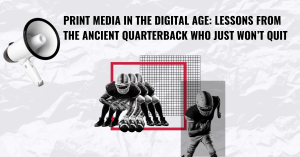As the medium faces extinction, there are print principles that can be applied to cutting-edge digital content. Rebel is versed in all of them.
The decline of newspapers has been discussed for so long that the topic has its own robust Wikipedia page. But trying to pinpoint the moment when the medium will actually meet its demise is a little like declaring Tom Brady is washed-up: you’ll be right…eventually. But, for now, not so much.

Yes, your hometown rag still has a pulse. Those glossy, flippy things near the cash register? Those are called magazines, kids, and you can still find them strewn about the waiting room of your doctor’s or dentist’s office. A bookcase full of first editions might class up your Zoom background, but some of us actually like to crack those things open once in a while.
If I sound at all like your ornery, smartphone-phobic grandpa, it’s probably because I spent about a decade in the newspaper industry, where we had a fitting saying: “don’t be the grandpa in the nightclub.” In other words, shed those stodgy sensibilities if you want to blend in with a hipper crowd — or risk appearing embarrassingly out of place.
That’s the tension media companies have been reckoning with for the better part of this young century. They’re entrenched in the digital revolution and constantly adapting to new technology. Yet they recognize print media’s premature burial in the public consciousness doesn’t quite square with the billions in advertising still spent in that space.
In short, Tom can still take your team to the Super Bowl. But, bless his heart, he might need a little help remembering how to get there.

What the numbers actually say about the decline of print media
Since it is indeed hard to separate fact from fiction on this topic, let’s pause to look at some of the more stark numbers illustrating print media’s slow yet steady march toward extinction, as rounded up by the Pew Research Foundation:
- Daily newspaper circulation and Sunday (coupons!) circulation each fell approximately 6% in 2020.
- The number of people working in newspaper industry jobs (reporters, editors, photographers, videographers) dropped to 30,820 in 2020, which is down 12% from 2019 and 57% from 2004 per the Bureau of Labor Statistics’ Occupational Employment and Wage Statistics.
- The average online visit time for the top 50 daily newspapers in the country (by circulation) was just shy of two minutes in the fourth quarter of 2020, which is down about 45 seconds from the figure first tracked by Pew in 2014.
- Ad revenue plummeted by 42% in 2020 amid the COVID-19 pandemic, suggesting a swift push toward the ledge the newspaper industry had been peering over for decades. The industry had been in steady decline from 2008 to 2018, dropping from $37.8 billion in revenue to $14.3 billion.
- On a more positive note, 39% of newspaper advertising revenue in 2020 came from the digital side of the ledger, a 4% jump from 2019 and a whopping 22% leap from when Pew first started performing this analysis back in 2011.
So what does it all mean? The collective shrinking of attention spans, a crippling addiction to social media scrolling, journalists of all stripes becoming political fodder — those obstacles are all well documented. (See? Tried to summarize all that to accommodate the aforementioned dinky attention spans.)
There’s also the not insignificant matter of corporate greed, which has manifested in the systematic dismantling of beloved publications by big media conglomerates that couldn’t care less about local readership.
Really, though, this can all be traced back to the beginning. No, not that far back. We’re talking about the lawless early internet days, when it seemed like a brilliant idea to make all the content that appeared in paid copies of the newspaper free to any and all comers on primitive websites with minimal advertising. Prior to the digital age, nobody batted an eye at the idea that a newspaper is, first and foremost, a business. Now, roughly 20 years on, that early misstep is still putting papers out to pasture.
The survivors are left trying to convince would-be readers that they should, gasp, pay for digital subscriptions. But with all that free noise out there, a disheartening number of people just sort of 🤷♂️ at the idea of spending so much as a cent to inform themselves. What’s the point? My conspiracy-peddling uncle always gives me the scoop. Plus his TikToks are hilarious.
Surviving the circulation swoon by adopting digital marketing ideals
Of course, some newspapers have managed to mitigate the loss of print revenue better than others. The New York Times and the Washington Post tripled their digital readership from 2017 to 2020, in part because they think and act like the most agile digital marketing agencies do. They’re prioritizing how best to present their content digitally and, in many cases, specifically optimizing it for handheld consumption. That, after all, is how the audience is asking to be served over and over and over again.
So why keep catering to the old, paper-and-ink, broadsheet way of consuming media? I asked the experts at Rebel.
“I think legacy newspapers have realized that great storytelling will drive audience engagement regardless of the format or platform it’s on,” said Kevin Vellturo, a senior content creator at Rebel Interactive Group and a fellow reformed journalist. “Once you’re able to separate yourself from a particular medium — and focus more squarely on what story you’re telling and how you’re telling it — the end result will be the same.”
Sounds a little like the ethos by which Rebel operates. We’re not married to any one medium. We’re dating them all. 😁
Newspapers have struggled because they take a superficial approach to numbers rather than trying to better understand the analytics behind audience behavior. We, on the other hand, are hyper-focused on mining the correct data to establish audience parameters — an essential step in the cultivation of a successful brand.
“Data is so important, but few understand it,” said Greg Shimer, Rebel’s director of account services and another veteran of the newspaper industry. “Just because you have Google Analytics, doesn’t mean you understand it. This is where Rebel shines — we know the tools, we know how to use them and how to help clients use them as well. Data is a short word that ultimately means ‘accountability.’”
Once we know who your audience is, where they are and how they like to consume content, we develop a strategy for delivering a media mix that will continuously resonate across all platforms. And the principles of traditional print media don’t have to be abandoned in the process. Here at Rebel, we’re experts at straddling the line between the old ways and the new. We embrace cutting-edge creative marketing services but we see the value in employing factual and compelling storytelling strategies.
Whatever analogy you want to use — the grandpa who insists on stumbling around the club or the quarterback who refuses to hang up his cleats — there’s no doubt it can be applied to print media. We’re here to help you extract wisdom from the past while keeping your eyes trained on the future.
Find out more about how Rebel can help you take tried and true media print principles for a modern spin without sweating any of the industry’s limitations.

